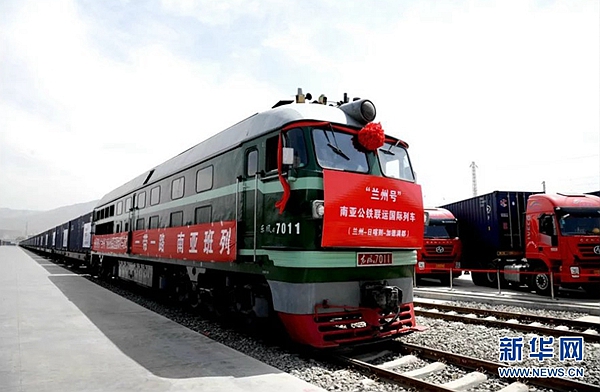China's rail: A Nepali dream
- By Mahendra Subedi
 0 Comment(s)
0 Comment(s) Print
Print E-mail China.org.cn, December 12, 2017
E-mail China.org.cn, December 12, 2017

China opens its first combined transport service to Nepal on May 11, 2016. [Xinhua]
Currently, Nepal is at the helm of a parliamentary election, the first of its kind after the new constitution. As the nation is gripped by the election fever, an alliance of two major communist parties -- CPN (Maoist Centre) and CPN (UML) -- has generated heated debates on infrastructure developments. The first and second phases of polling are over, and the preliminary results have clearly shown landslide victory of the communist parties.
During the nationwide campaigns, two top leaders of Nepal's major communist parties Pushpa Kamal Dahal 'Prachanda' and KP Sharma Oli have repeatedly promised to link Nepal and China via rail services. Excited after the polls suggest the possibility of a landslide victory for the communist parties, the two former communist prime ministers have received warm applauds from the general public and the private sector for vowing to bring in more Chinese investments to Nepal.
Following the election alliance, the two communist parties have also issued a joint election commitment paper where they have promised to connect the eastern part of Nepal to the western belt and Rasuwa-Kathmandu-Pokhara-Lumbini via electronic rail services in the coming five years.
Railway services are a long-awaited yet unfulfilled dream for the Nepalis. This is a serious issue since if Nepal were to use China's existing high-speed train of 300 km per hour, Nepal's east to west could be covered in about three hours while the journey from Kerung to Kathmandu, Kathmandu to Pokhara, and Pokhara to Lumbini could take only half an hour each.
Currently, the development of railway infrastructure has become a hot issue in discussions among scholars, university teachers and students, journalists and politicians too. In its editorial titled "A Rail to China" on November 12, Nepal's popular vernacular newspaper NayaPatrika daily stated that railway in Nepal has become an image; an opportunity and an impression of strangeness among folks. But recently, the possibility of railway services has emerged as a tangible and achievable reality, ending decades-long gossip, further states the editorial.
At a news conference in Kathmandu on November 17, Chinese Ambassador to Nepal Yu Hong said China is willing to become connected to Nepal via road and rail services. In the press brief organized after the 19th National Congress of the Communist Party of China to familiarize the Nepali media about the concept of Chinese President Xi Jinping, the Chinese ambassador also said China was committed to developing road and railways for deeper integration in economic, social, cultural and trade issues between the two countries.
Constructing the railways from China to Nepal is obviously an arduous task given the adverse geographic terrain. But, the Nepali dream for the railway is expected to materialize due to Nepal's participation in BRI, age-old close ties with China, Nepal's political commitment to development followed by an upcoming stable communist government and, most importantly, Nepalese citizens' deep rooted psyche to end the Indian high-handedness in Nepal that manifested in the economic blockade in 2015.
To quote the statements of Nepal's former Prime Minister, who is also a renowned architect, seems relevant here. "The extreme geography cannot limit us. Modern infrastructure technologies have offered many things for us. The Qinghai-Tibet Railway has already shown how modern railway technologies can link the most remote and difficult to reach places. So, linking China's Tibet autonomous region and Nepal is possible both through technical and economic means," Dr Bhattarai said in his speech made in the "21st Century Maritime Silk Road International Expo" in China's Guangdong Province.
Likewise, the dream for China's train to Nepal has come further closer after a high-level 35-member Chinese team visited Rasuwa, Kathmandu, Pokhara and Lumbini, to carry out the preliminary feasibility study of a railway in Nepal in the second week of November.
China's National Railway Administration Deputy Chief Zheng Jian and other high-ranking officials visited Nepal and had interactions with top-level bureaucrats of the Ministry of Physical Infrastructure and Transport in Kathmandu. As the alignment of the railways was an issue of discussions among others, the team shall prepare estimates for the total cost after working on the feasibility study. However, based on the preliminary survey, the construction is forecast to cost NPR 270 billion for the 100 km railway from the Chinese border town of Kerung to Kathmandu.
China is expected to construct a railway to Kerung, a small town along the Nepal-China border, by 2020 which will then stretch to connect to Nepal, given Nepal's political commitment. So, enhancing road links between Nepal and China is not only related to reducing transportation costs or trade promotion, rather it should be viewed in a bigger framework to overhaul the economies of the peoples in both the countries. The railway shall create a huge market and this in turn would yield productivity growth and cultural connectivity. And, China's role in railway development would be a landmark support for Nepal's stability and prosperity. This is what the Nepalis are expecting from their northern neighbor.
Mahendra Subedi is a Kathmandu-based journalist writing commentaries on international relations, labor migration and few other social issues.
Opinion articles reflect the views of their authors only, not necessarily those of China.org.cn.






Go to Forum >>0 Comment(s)